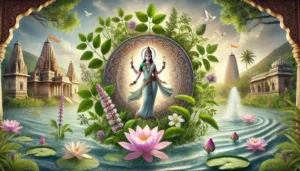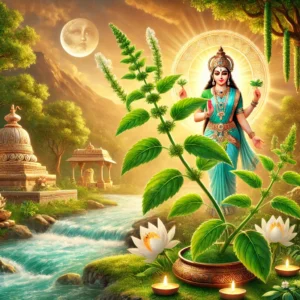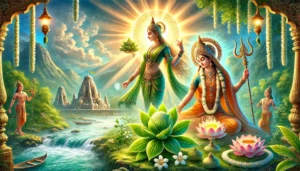
Why are Ganga and Tulsi holy in Hinduism?
The Significance of Tulsi, Ganga, and Other Feminine Symbols in Hindu Practices
Hinduism is deeply intertwined with nature, seeing divine presence in rivers, trees, mountains, and celestial bodies. Among the most revered elements of this spiritual tradition are feminine symbols such as Tulsi (Holy Basil), Ganga (the sacred river), and various goddesses, all of whom represent purity, devotion, nourishment, and cosmic energy. These symbols are not mere objects of worship but are deeply embedded in Hindu philosophy, rituals, and everyday life.
By understanding the significance of these feminine symbols, we gain insights into the spiritual and ecological consciousness of Hinduism, which emphasizes harmony between humans and nature.
Tulsi: The Sacred Plant of Devotion, Purity, and Healing
Tulsi (Ocimum sanctum), also called the Queen of Herbs, is one of the most sacred plants in Hinduism. It is believed to be an earthly manifestation of Goddess Lakshmi and a consort of Lord Vishnu. Growing and worshiping Tulsi is considered an act of immense merit.
Spiritual and Religious Importance
Symbol of Devotion: Tulsi represents unwavering devotion (bhakti). Worshiping Tulsi is considered equivalent to worshiping Lord Vishnu himself.
Daily Worship: Many Hindu households maintain a Tulsi Vrindavan (a special altar) in the courtyard, where prayers and lamps are offered every day.
Tulsi Vivah: The symbolic wedding of Tulsi with Lord Vishnu, performed during the Kartik month, marks the beginning of the Hindu wedding season.
Association with Krishna: Tulsi leaves are essential in Vaishnava rituals and are offered to Lord Krishna and Vishnu as a mark of devotion.
Medicinal and Environmental Significance
Tulsi is known for its numerous medicinal properties. It is a powerful immunity booster, stress reliever, and antibacterial agent.
It purifies the air by absorbing toxins and releasing oxygen.
Its environmental significance aligns with Hinduism’s belief in the sanctity of all life forms.
Table of Contents

Why are Ganga and Tulsi holy in Hinduism?
Ganga: The Divine Mother and Purifier
River Ganga is not just a physical river; she is worshipped as Ganga Mata, a goddess who purifies the soul and grants salvation. Her waters are believed to have divine energy, cleansing sins and liberating the soul from the cycle of rebirth.
Mythological and Spiritual Importance
Descent from the Heavens: King Bhagiratha performed intense penance to bring Ganga from the heavens to Earth to purify the ashes of his ancestors. Lord Shiva contained her immense flow in his matted locks before releasing her gently onto Earth.
Symbol of Purity and Moksha: Bathing in the Ganges, particularly at Varanasi, Haridwar, and Prayagraj, is believed to wash away sins and grant liberation (moksha).
Connection with Lord Shiva: As the bearer of Ganga in his hair, Lord Shiva represents control over cosmic energy and destruction of impurities.
Use in Rituals: Ganga water is used in Hindu ceremonies, from birth rituals to last rites. A few drops of Gangajal in food or water is believed to sanctify it.
Cultural and Environmental Influence
The Ganga Aarti at Varanasi, Haridwar, and Rishikesh is a grand spiritual ceremony that attracts millions of devotees.
Despite pollution concerns, efforts to clean and protect Ganga continue, emphasizing Hinduism’s ecological wisdom.
Other Feminine Symbols in Hinduism
- Cow (Gau Mata): The Nurturer and Giver
The cow is considered sacred in Hinduism, symbolizing nourishment, motherhood, and selfless giving.
Connection with Lord Krishna: Lord Krishna, the divine cowherd, played with and protected cows, highlighting their importance.
Cow’s Milk and Panchagavya: Cow products (milk, ghee, curd, urine, and dung) are used in Ayurveda and Hindu rituals.
Non-Violence (Ahimsa): The cow is seen as a divine mother, reinforcing the Hindu principle of non-violence.
- Goddess Saraswati: The Embodiment of Knowledge
Goddess Saraswati represents wisdom, arts, music, and learning. She is depicted with a veena (musical instrument), white garments, and a swan, symbolizing purity and knowledge.
Worship during Vasant Panchami: Students, scholars, and artists seek her blessings for intelligence and creativity.
Association with the Vedas: She is the goddess of speech (Vak Devi), inspiring sacred scriptures.
- Goddess Lakshmi: The Bestower of Prosperity
Goddess Lakshmi represents wealth, fortune, and well-being. She is worshiped widely, especially during Diwali, when people pray for financial stability and prosperity.
Material and Spiritual Wealth: While she blesses with financial abundance, she also represents inner wealth (dharma, bhakti, and jnana).
Gaja Lakshmi Form: She is often depicted with elephants, symbolizing royal splendor and spiritual wisdom.
- Goddess Durga: The Protector and Warrior
Goddess Durga is a fierce and powerful divine mother, symbolizing strength, righteousness, and the destruction of evil.
Navratri Festival: Hindus celebrate her victory over the demon Mahishasura, signifying the triumph of good over evil.
Ten Arms and Weapons: Each weapon she holds represents different aspects of divine power.
- Earth (Bhumi Devi): The Divine Mother
Mother Earth (Bhumi Devi) is regarded as a goddess who nourishes and sustains all life.
Respect for Nature: Hindu rituals emphasize environmental conservation, treating rivers, trees, and animals as divine.
Bhumi Puja: Before construction, Hindus perform Bhumi Puja to seek forgiveness from Mother Earth.
Symbolism of Feminine Energy in Hindu Philosophy
Hinduism sees the feminine principle (Shakti) as the fundamental creative force of the universe. This divine energy manifests in different forms, balancing the cosmos.
Creation and Nourishment: Goddess Lakshmi and Bhumi Devi sustain life.
Wisdom and Knowledge: Saraswati imparts knowledge and enlightenment.
Strength and Protection: Durga and Kali protect righteousness (dharma).
The concept of Ardhanarishvara (Shiva-Shakti union) further emphasizes the balance of masculine and feminine energies, signifying that both aspects are essential for universal harmony.

Why are Ganga and Tulsi holy in Hinduism?
Conclusion
The reverence for Tulsi, Ganga, and other feminine symbols in Hinduism reflects the deep respect for divine femininity and nature. These sacred symbols teach spiritual lessons, promote environmental awareness, and provide a holistic vision of life.
By understanding their significance, we can appreciate the wisdom of Sanatan Dharma, which seamlessly integrates devotion, ecology, and well-being. Tulsi reminds us of purity and devotion, Ganga symbolizes purification and salvation, and goddesses embody wisdom, prosperity, and strength.
In an era of environmental crises and material distractions, these sacred symbols encourage us to reconnect with nature, respect feminine energy, and live in harmony with the universe.
FAQs ( Frequently Asked Questions )
Here are some FAQs on Ganga, Tulsi, and the Sacred Feminine: Symbols of Purity and Devotion in Hindu Dharma
- What is the significance of the Ganga in Hindu Dharma?
The Ganga is considered the holiest river in Hinduism, symbolizing purity, spiritual cleansing, and divine grace. It is believed that a dip in its waters washes away sins and grants moksha (liberation from the cycle of birth and death). Goddess Ganga is also regarded as a symbol of the flow of divine knowledge and spiritual liberation.
- Why is Tulsi considered sacred in Hinduism?
Tulsi, also known as the holy basil, is revered for its medicinal and spiritual properties. It is associated with the goddess Lakshmi and is believed to have purifying effects on both physical and spiritual levels. Devotees worship Tulsi in the form of a plant and use its leaves for offerings in rituals, especially those dedicated to Lord Vishnu and Lord Krishna.
- How are Ganga and Tulsi connected in Hindu tradition?
Both Ganga and Tulsi are considered symbols of purity and devotion. Tulsi leaves are often offered to Lord Vishnu and Lord Krishna, whose divine connection with the Ganga is well established. The Ganga herself is seen as a purifier, and the Tulsi plant, often seen near sacred sites like the banks of the Ganga, signifies spiritual growth and a connection to the divine.
- What role does the Sacred Feminine play in Hinduism?
The Sacred Feminine in Hinduism represents the divine energy (Shakti) that governs the universe. Goddesses such as Durga, Lakshmi, Saraswati, and Parvati personify different aspects of this energy, including creation, preservation, and destruction. These goddesses embody the nurturing, protective, and transformative powers of the divine feminine.
- How do the Ganga and Tulsi embody aspects of the Sacred Feminine?
The Ganga is often depicted as a goddess (Ganga Mata), representing purity, compassion, and grace. She is the embodiment of divine feminine energy flowing through the cosmos. Similarly, Tulsi, as a goddess and a plant, represents devotion, purity, and protection. She symbolizes the feminine principle of nurturing and spiritual sustenance.
- Why is Ganga worshiped in Hindu temples and homes?
Worship of Ganga, whether through the recitation of her sacred hymns or through rituals involving water from the river, is believed to purify the soul. It is also a way of expressing gratitude for her divine grace. Many homes and temples feature a small idol or image of Goddess Ganga to invoke her blessings of purity and spiritual awakening.
- How does the Sacred Feminine relate to the concept of devotion in Hinduism?
In Hinduism, devotion (bhakti) is central to spiritual growth. The Sacred Feminine embodies the compassionate and nurturing aspects of devotion. By worshiping goddesses like Durga or Lakshmi, devotees seek blessings for protection, prosperity, and spiritual guidance. The feminine energy represents the loving, transformative power of devotion that helps transcend worldly struggles.
- What is the significance of offering Tulsi leaves to deities?
Offering Tulsi leaves is a symbol of devotion and purity. In Hindu rituals, especially those dedicated to Vishnu, offering Tulsi is considered a highly auspicious act. The plant is believed to have divine properties, making the offerings spiritually significant. It is also said that the goddess Tulsi herself is pleased by the offering and grants blessings of purity, health, and spiritual progress.
- What lessons can be learned from the symbolism of the Ganga and Tulsi?
Both the Ganga and Tulsi teach important spiritual lessons about purity, devotion, and the power of divine grace. The Ganga teaches humility and the need to surrender to the divine flow, while Tulsi encourages devotion, discipline, and the importance of nurturing the soul. Together, they symbolize the balance between spiritual purity and the divine presence in our lives.
- How can one incorporate reverence for Ganga and Tulsi into daily life?
You can incorporate reverence for these sacred symbols by maintaining a Tulsi plant at home, offering prayers or recitations to Ganga, and seeking to live with purity of thought, word, and action. Regular bathing in the Ganga or keeping water from the river at home also helps maintain a spiritual connection. Emulating the virtues of purity, devotion, and compassion that both the Ganga and Tulsi embody will deepen one’s spiritual practice.
These FAQs provide a good foundation for understanding the deep spiritual and symbolic significance of the Ganga, Tulsi, and the Sacred Feminine in Hindu Dharma.
Summary
The Ganga, Tulsi, and the Sacred Feminine are powerful symbols of purity, devotion, and spiritual nourishment in Hindu Dharma.
- The Ganga (River Ganges): Regarded as the holiest river in Hinduism, the Ganga is personified as a goddess, Ganga Devi. She is believed to purify all sins and grant liberation (moksha) to those who bathe in her waters. The river’s sacredness is tied to the mythology of her descent from the heavens, brought to Earth by Lord Shiva. She represents both physical and spiritual purity, a vital force for sustenance, and a divine mother who nurtures all life.
- Tulsi (Holy Basil): Tulsi is revered as a sacred plant, symbolizing devotion, purity, and divine grace. It is often associated with the goddess Lakshmi and Lord Vishnu. The plant is considered an embodiment of the goddess Vishnupriya and is worshipped for its medicinal and spiritual benefits. The daily worship of Tulsi brings spiritual growth, protection, and purification of the soul.
- The Sacred Feminine: The concept of the Divine Feminine (Shakti) in Hinduism represents the dynamic energy of creation and the nurturing aspect of divinity. This includes various goddesses like Parvati, Lakshmi, Saraswati, and Durga, each embodying different aspects of femininity—wisdom, wealth, power, and compassion. The Sacred Feminine is revered as the source of all life and creation, signifying the importance of nurturing, protection, and the power of transformation.
Together, these symbols emphasize purity, devotion, and the importance of feminine energy in both the material and spiritual realms of Hinduism. They remind devotees of the interconnectedness between nature, the divine, and the human spirit, encouraging worship and reverence in daily life.
Unlock the Ancient Wisdom of Sanatan Dharma – Join Us on YouTube!
👉 Subscribe now to Prachin Sanatan Dharma and embark on a journey of enlightenment.
Explore timeless teachings, spiritual insights, and cultural richness on our YouTube channel, Prachin Sanatan Dharma. Dive deep into the essence of Sanatan Dharma through captivating videos that inspire and educate.
Related Articles
- Restful Nights: Ayurvedic Remedies and Traditional Indian Practices to Overcome Insomnia and Late-Night Habits
- The Tridevi: Lakshmi, Saraswati, and Parvati – Their Roles and Powers
- “Divine Creatures of Ancient Indian Scriptures: Exploring the Role of Animals in the Vedas, Puranas, and Mahabharata”
- Nature and Spirituality: Exploring the Sacred Essence of the Himalayas, Ganga, and Other Natural Wonders”
- “Reviving the Gurukul System: Relevance and Lessons for Modern Education”
- “Exploring Greek and Indian Mythology: Similarities Between Greek and Indian Mythology “
- “Embracing Sattvic Living: Harmonizing Mind, Body, and Soul Through Food and Lifestyle”
- “Charity and Prosperity: Exploring the Concept of Daan and Its Financial Relevance in Modern Life”
- How to Build an Eco-Friendly Home Inspired by Vastu Shastra
- Comparison of Ancient and Modern Sports: How Traditional Sports Have Influenced Contemporary Games
- “Timeless Lessons from Ancient Tales: Linking Samudra Manthan and Ganga’s Descent to Modern Ecological Challenges”
- “Reviving Sanskrit: How AI is Preserving Ancient Languages for the Future”
- “Mathura: The Sacred Land of Lord Krishna’s Divine Leelas”
- Investing for Future Generations: Lessons from Indian Traditions on Legacy Building and Wealth Preservation
- “Ancient Indian Wisdom: Timeless Lessons for Tackling Today’s Climate Crisis”
- “Artificial Intelligence and Spirituality: Transforming Ancient Practices for the Modern World”
- “Gold and Real Estate in India: Timeless Assets Shaping Financial Strategies”
- Tradition Meets Innovation: The Evolution of Technology in Hindu Rituals
- End-of-World Myths: Exploring Kali Yuga in Hinduism and Ragnarök in Norse Mythology
- Garuda, Pegasus, and Dragons: The Universal Ties of Mythical Beasts Across Cultures
- “Ancient Vimanas: Mythical Flying Machines or Evidence of Advanced Technology?”
- Time Travel in Hindu Mythology: The Fascinating Tales of Kakudmi and King Raivata
- “Divine Feminine Power in Hindu Mythology: The Legends of Durga, Saraswati, and Lakshmi”
- “Divine Beings of Sanatan Dharma: The Spiritual Significance of Sacred Animals in Hinduism”
- “Symbolism in Mythological Art: Unlocking Hidden Meanings in Ancient Temple Carvings”
- “Exploring Technological Advancements in Ancient India and Civilizations: Vimana, Metallurgy, & Water Management systems”
- Unveiling the Mysteries: Ancient Temples of Sanatan Dharma , Mysterious Temples of India
- “The Scientific Knowledge of Sanatan Dharma: Ancient Wisdom Meets Modern Science”
- Ancient Indian Sports and Games: Celebrating a Legacy of Skill, Strength & Strategy”
- “Exploring the Cosmic Link: The Connection Between Astronomy and Vedic Astrology”
- The Power of Sanskrit: Unlocking the Divine Language of the Gods
- “The End of Kaliyuga: A Sanatan Insight into the World’s Final Chapter”
- Explore more articles on Prachin Sanatan Yuga.
Why are Ganga and Tulsi holy in Hinduism? Why are Ganga and Tulsi holy in Hinduism? Why are Ganga and Tulsi holy in Hinduism? Why are Ganga and Tulsi holy in Hinduism? Why are Ganga and Tulsi holy in Hinduism? Why are Ganga and Tulsi holy in Hinduism? Why are Ganga and Tulsi holy in Hinduism? Why are Ganga and Tulsi holy in Hinduism? Why are Ganga and Tulsi holy in Hinduism?
Why are Ganga and Tulsi holy in Hinduism? Why are Ganga and Tulsi holy in Hinduism? Why are Ganga and Tulsi holy in Hinduism? Why are Ganga and Tulsi holy in Hinduism? Why are Ganga and Tulsi holy in Hinduism? Why are Ganga and Tulsi holy in Hinduism? Why are Ganga and Tulsi holy in Hinduism? Why are Ganga and Tulsi holy in Hinduism? Why are Ganga and Tulsi holy in Hinduism?
Why are Ganga and Tulsi holy in Hinduism? Why are Ganga and Tulsi holy in Hinduism? Why are Ganga and Tulsi holy in Hinduism? Why are Ganga and Tulsi holy in Hinduism? Why are Ganga and Tulsi holy in Hinduism? Why are Ganga and Tulsi holy in Hinduism? Why are Ganga and Tulsi holy in Hinduism? Why are Ganga and Tulsi holy in Hinduism? Why are Ganga and Tulsi holy in Hinduism?
